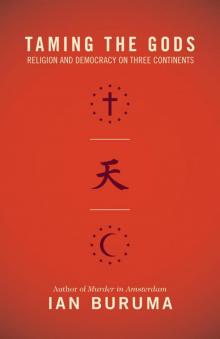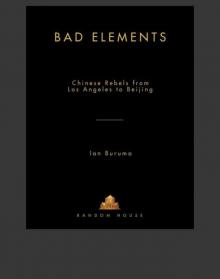- Home
- Ian Buruma
A Japanese Mirror Page 15
A Japanese Mirror Read online
Page 15
Sexual confusion was an integral part of the earliest Kabuki theatre. A seventeenth-century Confucian scholar, Hayashi Razan (1583–1657), remarked indignantly that ‘the men wear women’s clothing; the women wear men’s clothing, cut their hair and wear a man’s topknot, have swords at their sides, and carry purses.’3 Out of this confusion, helped by the fact that after 1629 female players were banned by the government, grew what is perhaps the highest art of female impersonation in the world: the onnagata.
The onnagata in the Kabuki theatre does not attempt to impersonate a specific woman so much as an idealized version of Woman, such as one sees in woodblock prints. He is able to stylize the ideal Woman, precisely because he is a man. Even if he lives his daily life as a woman, which some onnagata used to do, he still remains a man. The sexual tension and the distance necessary to his art stay whatever he does, short of an operation, which, in any case, was rather difficult to arrange in the seventeenth century.
The ideal is to make the sexual transition seem as effortless as possible. In the words of the great master of these roles, Yoshisawa Ayame (1673–1729): ‘If [the actor] tries deliberately to make his interpretation elegant, it will not be pleasing. For this reason, if he does not live his normal life as if he were a woman, it will not be possible for him to be called a skilful onnagata.’4 He also said that ‘if an actress were to appear on stage she could not express ideal feminine beauty, for she could only rely on the exploitation of her physical characteristics, and therefore not express the synthetic ideal. The ideal woman can only be expressed by an actor.’5
Goethe was an admirer of castrati artists for the same reason: ‘… a double pleasure is given in that these persons are not women, but only represent women. The young men have studied the properties of the sex in its being and behaviour; they know them thoroughly and reproduce them like an artist; they represent not themselves, but a nature absolutely foreign to them.’6
This kind of skill has little to do with age. I have seen an actor in his seventies playing the young wife of a warrior, who was acted a trifle bashfully by his own son. Because of his complete command over the technique of female role playing, he could still create the illusion of female beauty. It is a very artificial beauty, of course, but this is precisely the point: ‘the synthetic ideal’.
Influenced by nineteenth-century European ideas about naturalism, attempts have been made in the past to have women play female roles in the Kabuki theatre. It simply did not work: they looked too natural; they lacked the beauty of artifice; the only way they could achieve the desired effect was to imitate men impersonating women.
An important point about female and male impersonation in Japan and elsewhere in Asia, is that it rarely becomes caricature; it is never a send-up in the way that, say, Barry Humphries is or drag shows in pubs are. One must, of course, bear in mind that transvestite acting was a serious art in Europe too until the dawn of Reason put a stop to it in the seventeenth century.7
There is a nightclub in Tokyo run by a famous female impersonator called Miwa Akihiro. The customers are seated in rococo chairs under a crystal chandelier in front of an onyx fireplace amidst marble statues of nude boys and vases filled with peacock feathers. The atmosphere is utterly serious. ‘Madame will be arriving presently’, whispers one of the waiters dressed in a red velvet dinner jacket. And so she does, looking glamorous in her low-necked evening dress.
As she sings her usual repertoire of French chansons in Japanese in the warbling style of the 1930s, the people are visibly moved. ‘Oh, she’s looking lovely tonight’, says an elderly gentleman to his wife. And a tear rolls down the scarred cheek of a tough-looking character immediately recognizable as a member of the gangster community.
To a Western observer all this is the highest of Camp. To many Japanese it is simply beautiful. Camp rests on a sense of irony; the irony of a serious attempt to reach an impossible ideal, the gap between human inadequacy and the grandiose goal.8 Camp is always ‘too much’, ‘too fantastic’, ‘fancy a man trying to look like a woman’. It is often said that the Japanese lack a sense of irony. As a general statement this is probably true. To a Westerner with a Camp sense of humour much in Japanese culture, from the plastic flowers in the streets to the electronic bird noises in department stores and, yes, even the Takarazuka theatre, seems Camp. The point is, though, that there is no gap between attempt and ideal in Miwa’s club or the Kabuki theatre or the Takarazuka: people do not pretend that the ideal has anything to do with reality. They enjoy seeing Lady Macbeth played by a famous Kabuki star, precisely because it is more artificial, thus more skilful, in a word, more beautiful.
It is a universal truism that sexual attraction is enhanced by a certain amount of ambivalence. The true 100 per cent he-man is usually a little ridiculous rather than devastating. Japan, in particular, has a tradition of rather girlish heart-throbs. The jeune premier in romantic Kabuki dramas is usually a pale, slim youth who invites maternal protection. The attraction of ambivalence appears to be as strong as ever. According to a recent poll in a woman’s magazine the two ‘sexiest stars’ of 1981 were Tamasaburo, a Kabuki actor specializing in female roles, and Sawada Kenji, a pop singer who likes to perform in semi-drag, more female than male.
There are social reasons too for the popularity of transvestite acting. Like everywhere else, learning to play the role of one’s sex is part of social training in Japan. In fact one is constantly reminded of one’s gender and is expected to behave accordingly. But not as soon as one is born; first comes that state of grace, the safe, warm, maternal world of early childhood when no role-playing is demanded quite yet and no real distinctions exist. In the words of the psychiatrist Kawai Hayao, ‘there is no distinction in the all-enveloping world of the mother between man and god, good and bad, man and woman’.9 This explains, in his opinion, why it seems so hard for many Japanese to escape from this world, to become adults.
The sexual ambivalence of the Takarazuka theatre and the girls’ comic-books upon which many of its plays are based are manifestations of this. The critic Imaizumi Fumiko believes that the evident desire not to be female is often misunderstood as a kind of worship of men. Girls do not want to be men, she thinks, but ‘their deepest desire is to be neither male nor female – in short, they wish to be sexless’.10 This is not because of some innate fear of the female condition, some biological taboo, but, according to Imaizumi, because they realize that becoming an adult woman means playing a subservient role in life. ‘They take on this role, knowing that in fact the difference between women and men is really a matter of appearances. And because of this, they also feel that reality and dreams can be reversed simply by changing those appearances.’11
This would certainly help to explain the phenomenal success of the most popular girls’ comic ever staged by the Takarazuka. Called ‘Rose of Versailles’ it was later made into an atrocious film strictly for the Japanese market by the French director Jacques Demy. Young Japanese girls showed more taste than the producers, however, for the film was a disaster, unlike the play and the comic.
In this story the roles are indeed reversed: the hero/heroine called Oscar is born a girl not long before the French Revolution, but she is raised as a boy to succeed in a family of generals. Thus this androgynous fair-haired soldier becomes part of Marie-Antoinette’s personal bodyguard. The tale ends with Oscar somewhat incongruously dying for the Revolution. But this piece of Republican sentiment inserted by the authoress, Ikeda Riyoko, for the edification of her readers, cannot be the main reason for the popularity of the work. More important by far is the ambiguous love life of the heroine.
Growing up as a boy, her best childhood companion is André, the son of her nanny. After she helps him out of a nasty situation when he almost kills Marie-Antoinette, his loyalty knows no bounds: in true samurai fashion he vows to die for her if necessary.
But, despite living like a man, Oscar falls in love with a Swedish nobleman named Von Felsen and she spends one romantic
night dancing with him, wearing a dress. Still, once in drag, always in drag, and she soon changes back into her military uniform. Besides, Von Felsen is already in love with Marie-Antoinette.
But then André, in his turn, declares his ardent love – for Oscar, not Von Felsen – repeating his willingness, his desire even, to die for her. Moved by this demonstration of sincerity Oscar ‘throws off her aristocratic cloak and reveals her beautiful self’. On stage the chorus goes: ‘I love you for your nobility, your purity, your beauty, your friendly smile, your white face [sic], your shining blue eyes. I love you and I want to die …’
Of course this will not do, she being an aristocrat and he a humble groom. The dénouement is classic Kabuki: first André is conveniently shot during a fight between the rebels and the troops. But the most splendid death is reserved for the true hero/heroine: Oscar, fair hair waving, blue eyes flashing, storms the Bastille and is struck down by a great big cannon ball, ‘blood colouring her breast red as the rose of Versailles’.
In the grand finale André, standing tall in a chariot drawn by Pegasus snorting clouds of dry ice, pulls Oscar’s spirit on board and side by side the ill-fated lovers ascend to a spectacular Heaven, where their love will burn in eternity. The entire cast assembled at the pearly gates, hardly visible now because of the flashing lights and the dry ice, erupts in the following boisterous finale:
In the flashing golden light
The guardsman’s uniform burns red
Fair hair waving, she takes the reins of the chariot.
Ah, those blue eyes, ah, the waving fair hair.
This may sound like a piece of Nazi propaganda staged by Leni Riefenstahl. And indeed the popularity among young Japanese girls of late Visconti films, Helmut Berger and the extravagant posturing of David Bowie, does seem to point to a taste for the Teutonic bizarre. I once asked a Takarazuka actress what had attracted her to this type of theatre. Akogare, she replied, a word usually translated as ‘yearning’, ‘longing’ or even ‘adoration’. It is used for people, places and ideals that seem impossibly far away, such as for example akogare no Pari, Paris of our dreams. It is the idealization of the unattainable, something like building paradise fifty miles from Osaka.
Possibly modern young girls look at fantasy European aristocrats in the same way that Edo audiences watched swaggering samurai on the Kabuki stage: far away and imbued with special powers. But to see this simply as a form of power worship, as some people do, is to miss the point. For there is a streak of deep pessimism running through this, or at least a tragic sense of mono no aware, the pathos of things.
The heroes never win. Kabuki samurai almost invariably end up getting killed or else killing themselves. Oscar and André can be lovers only in Heaven, never in this sad, evanescent world of ours, just like Chikamatsu’s tragic heroes and heroines more than three hundred years ago. As the end poem of another girls’ comic says: ‘Look at the dreams of young girls, who grow up: they are like castles of glass.’ Growing up inevitably means tragedy.
The young girl’s dream, then, is to go as far away as possible, sexually, emotionally, geographically, from everyday reality: in outer space or in fantastic pseudo-European palaces, or even a combination of both, such as in ‘The Adventures of Puppy From the Star Called Mill’. The sets of this play are pure Takarazuka paradise: eighteenth-century French ballrooms in a grand palace filled with tall, long-legged, short-cropped girls in blonde wigs, Donau monarchy guardsmen’s uniforms and speaking in artificial mannish voices – Erich von Stroheim in Japanese teenager land.
The adults in this piece are all corrupt, deceitful and calculating. The young girls suffer terribly, but are rescued in the end by two androgynous extra-terrestrials, who can make time stand still and wear pendants with which they can see through people’s hearts. This causes havoc, for unspoken thoughts become known to all and as one of the E.T.s points out: ‘The people in this world live by cheating each other. They know they are being cheated, and so they cheat others. That is their way of life.’
The despair about growing up and the hostility to the adult world are remarkable for their intensity. The Takarazuka heroines echo the sentiments of Midori, the young girl destined to be a prostitute in Higuchi Ichiyo’s ‘Growing Up’: ‘If only she could go on playing house forever with her dolls for companions, then she’d be happy again. Oh, she hated, hated, hated this growing up.’
Although the Peter Pan syndrome of wanting to remain young for ever is certainly universal, growing up is perhaps even harder than usual in a world of contradictory values. We have already noted that marriage is a necessary condition of Japanese adulthood. In traditionally arranged marriages suitability still takes precedence over love. At the same time fashionable magazines for the young preach the relatively new gospel of romance. So what is a poor girl to do? In a sense every girl who conforms to tradition finds herself in Midori’s predicament. The Takarazuka theatre tends to attract such girls and its answer to them is nothing more than a variation of the traditional attitude: resign yourself to the demands of society and for the rest, dream on, young lady, dream on. Dream of being an eternal virgin or, better still, sexless in a world of European aristocrats and friendly E.T.s.
Although this is not quite so apparent in the Takarazuka theatre, the dream has a darker side too. Girls’ comics show a strong preoccupation with evil, horror and death. This is no doubt partly due to the universal horrors of puberty, during which physical changes can be traumatic. Identification with monsters in girls’ stories is understandable at an age when many see themselves as ogres in the mirror every morning.
Typically, though, evil is no more absolute in these comics than it is in ancient Japanese mythology. Even the blackest characters can be redeemed by demonstrations of remorse and sincerity. In one comic, entitled ‘The Glass Castle’, set in a timeless London, Marisa, who has the ‘character of an angel’, is bullied, tortured and cheated in the most brutal manner by her evil stepsister, Isadora, who even murders their father, a benign but distant figure in the best Japanese patriarchal tradition. But she does repent in the end, confessing how lonely she felt and how miserably inferior to her angelic sister.
This is the magic formula, for she is instantly forgiven. Like a true Japanese heroine, angelic Marisa even decides to sacrifice herself, taking the blame for her sister’s murder. ‘This world is as breakable and impermanent as glass,’ says the balloon above Marisa’s head, as she is taken to prison where she soon perishes.
Isadora could be seen as Marisa’s adult alter ego. Marisa lives in the all-forgiving world of childhood, the ‘dimly white dream-world’. Apart from murdering her father, Isadora more or less behaves in the way that adult society expects. Family, marriage, and social status are always uppermost in her mind, but, as she laments in the end, ‘one small lie leads to worse and worse crimes’. It is inevitable that Marisa, or childhood if you like, is sacrificed. Time cannot stand still, there is no turning back.
This pessimism is deeply rooted in Japanese culture. In Western Europe and especially in the USA people, ideally, if not always actually, choose their own destinies in an imperfect world which we have to improve ourselves. Thus many youthful fantasies, of girls and boys, are about saving the world from the devil. The world is not innately bad, it is only sinful human beings who make it so. This, at least, is the Christian, or more precisely, the Protestant view, in the shadow of which many Occidentals are raised, whatever their creed. And as a large number of Hollywood heroes have shown us, the possibilities for individuals to change the world are infinite. That, after all, is why Mr Smith went to Washington and Mr Deeds to town.
Also, up to a point, there is more tolerance in the West of nonconformist behaviour. In Japan, as the proverb says, ‘a nail that sticks out, must be hammered in’. The pressure to conform outwardly to fixed rules of conduct is far more relentless than it is in Western countries. Most Japanese are mortally afraid of seeming odd or strange, or in any way different from their neighbo
ur. ‘Ordinary’ (heibon) is cited by the majority of Japanese as the most desirable thing to be.
This is not the same as the Christian idea of being good. Conscience, that disturbing angel with whom so many literary characters in the Occident wrestle, carried to its Protestant extremes means that one’s only confidant is God. It is to Him and not just to society that one is ultimately responsible. Conscience, in the Christian sense, transcends society. Japanese etiquette does not.
Conscience, individual integrity, being true to oneself, or whatever one wishes to call it, appears to count for less than the expectations of the social environment one happens to live in. When things go wrong, it is rarely the responsibility of individuals. A person might take responsibility and even commit suicide, but this too is a question of doing the right thing; for the one who takes his own life is not necessarily the one who did anything wrong. Good Marisa dies for bad Isadora.
Thus, in fiction at least, people are always the victims of fate, never its master. It is society, often described as dirty or polluted (yogoreteiru), which makes people bad, not the other way round. Society forces one to act, to behave as expected, which may not be the way one feels at all. Though being ‘true to oneself’ is not a Japanese maxim, and behaving as expected is certainly the proper way, there is still a nagging conflict here: for the more one is forced to act, the further one drifts away from the pure state of childhood. Thus the emphasis in so many Japanese stories, including those on the Takarazuka stage, is on the ending of youth, on the destruction of it, rather than its flowering. The alternative is to remain an eternal youth or virgin, neither man nor woman, which is the same as not growing up at all.

 A Japanese Mirror
A Japanese Mirror Taming the Gods
Taming the Gods The China Lover
The China Lover A Tokyo Romance
A Tokyo Romance Theater of Cruelty
Theater of Cruelty Year Zero
Year Zero The Wages of Guilt
The Wages of Guilt Murder in Amsterdam
Murder in Amsterdam Bad Elements
Bad Elements Their Promised Land
Their Promised Land Occidentalism
Occidentalism Anglomania
Anglomania Inventing Japan: 1853-1964 (Modern Library Chronicles)
Inventing Japan: 1853-1964 (Modern Library Chronicles) The Missionary and the Libertine
The Missionary and the Libertine